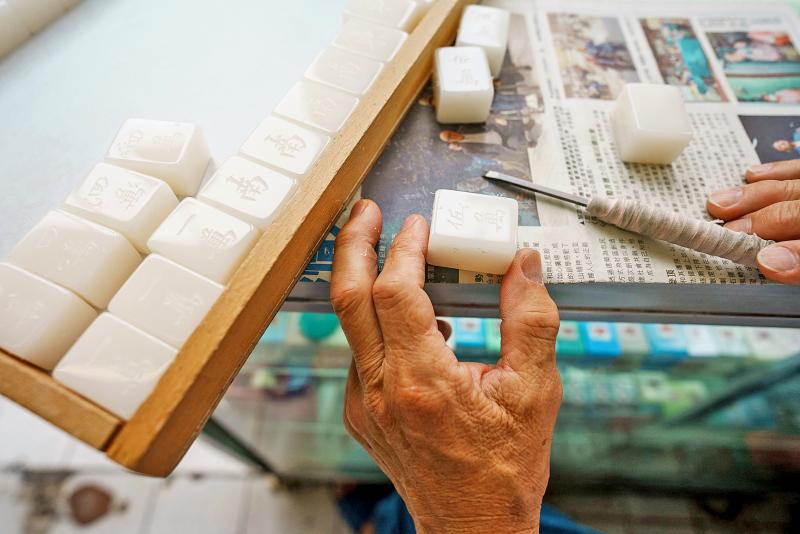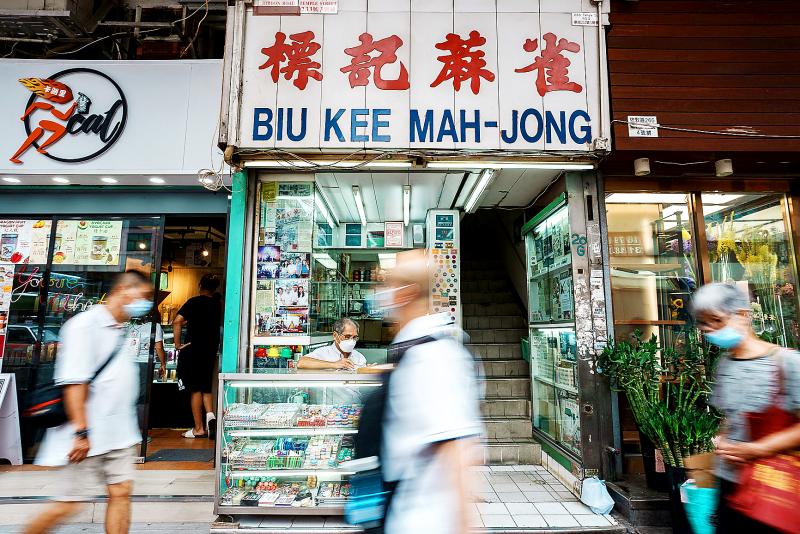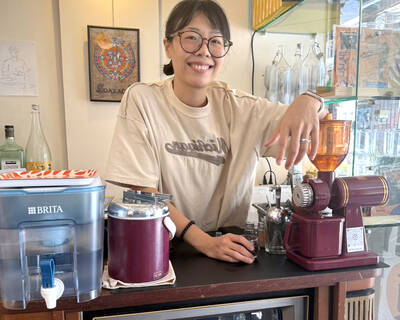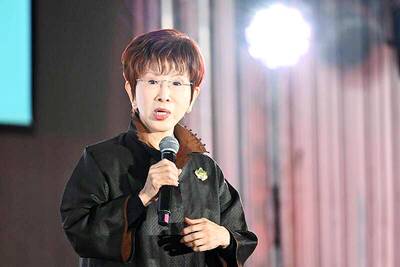Eyebrows furrowed in careful concentration as he chisels images and Chinese characters onto mahjong tiles, 70-year-old Cheung Shun-king is one of the last craftsmen of his kind in Hong Kong.
Hand carving playing tiles for the popular Chinese game used to be a source of income for many, but the introduction of much cheaper machine-made sets whittled away at their customer base and turned their work into a rarity.
Cheung’s family alone used to own four separate shops, where as a teenager he learned his trade.

Photo: AFP
Now only one remains.
“I have given my youth to it,” he says of his work. “I don’t know if I’ll have the energy to carry on in a few years, but for now, I’ll continue to do it.”
Cheung’s store is on a street lined with mahjong parlors, but none of them buy their tiles from him.

Photo: AFP
“My mahjong sets are expensive,” he admits.
A full set of hand-carved tiles costs HK$5,500 (US$700), he says, whereas machine-carved ones are around HK$2,000.
The price reflects the time spent making them. Industrial production of tiles takes about an hour, but it takes five days for Cheung to complete the process of carving and coloring his tiles.
Many of his customers buy sets as souvenirs and often request customized images. But Cheung thinks this recent surge in interest in an old tradition may be ephemeral.
“It is only in these last few years that people have felt a sense of nostalgia” and come to buy his tiles, he says. “What if a few years later no one feels nostalgia?”
Despite his belief that his industry will continue to decline, Cheung says he will work for as long as he can, until there is no demand.
He used to conduct workshops for young people but does not want to take on apprentices because of his pessimism.
“To learn [this skill] isn’t a matter of one or two months — attempting it wouldn’t work if you didn’t immerse yourself in it for two to three years,” Cheung says.
“If, by then, handcrafted mahjong tiles are no more a trend, then this skill would become useless.”
Cheung does not know how to play mahjong himself — his interest lies only in crafting the tiles.
He says that being called an artist, however, is flattering, and a “big compliment” for him.
“If others say it is art, then it is art. For me, it is my job, as I have to make a living.”

Cheng Ching-hsiang (鄭青祥) turned a small triangle of concrete jammed between two old shops into a cool little bar called 9dimension. In front of the shop, a steampunk-like structure was welded by himself to serve as a booth where he prepares cocktails. “Yancheng used to be just old people,” he says, “but now young people are coming and creating the New Yancheng.” Around the corner, Yu Hsiu-jao (饒毓琇), opened Tiny Cafe. True to its name, it is the size of a cupboard and serves cold-brewed coffee. “Small shops are so special and have personality,” she says, “people come to Yancheng to find such treasures.” She

The low voter turnout for the referendum on Aug. 23 shows that many Taiwanese are apathetic about nuclear energy, but there are long-term energy stakes involved that the public needs to grasp Taiwan faces an energy trilemma: soaring AI-driven demand, pressure to cut carbon and reliance on fragile fuel imports. But the nuclear referendum on Aug. 23 showed how little this registered with voters, many of whom neither see the long game nor grasp the stakes. Volunteer referendum worker Vivian Chen (陳薇安) put it bluntly: “I’ve seen many people asking what they’re voting for when they arrive to vote. They cast their vote without even doing any research.” Imagine Taiwanese voters invited to a poker table. The bet looked simple — yes or no — yet most never showed. More than two-thirds of those

In July of 1995, a group of local DJs began posting an event flyer around Taipei. It was cheaply photocopied and nearly all in English, with a hand-drawn map on the back and, on the front, a big red hand print alongside one prominent line of text, “Finally… THE PARTY.” The map led to a remote floodplain in Taipei County (now New Taipei City) just across the Tamsui River from Taipei. The organizers got permission from no one. They just drove up in a blue Taiwanese pickup truck, set up a generator, two speakers, two turntables and a mixer. They

Former Chinese Nationalist Party (KMT) chairwoman Hung Hsiu-chu’s (洪秀柱) attendance at the Chinese Communist Party’s (CPP) “Chinese People’s War of Resistance Against Japanese Aggression and the World Anti-Fascist War” parade in Beijing is infuriating, embarrassing and insulting to nearly everyone in Taiwan, and Taiwan’s friends and allies. She is also ripping off bandages and pouring salt into old wounds. In the process she managed to tie both the KMT and the Democratic Progressive Party (DPP) into uncomfortable knots. The KMT continues to honor their heroic fighters, who defended China against the invading Japanese Empire, which inflicted unimaginable horrors on the